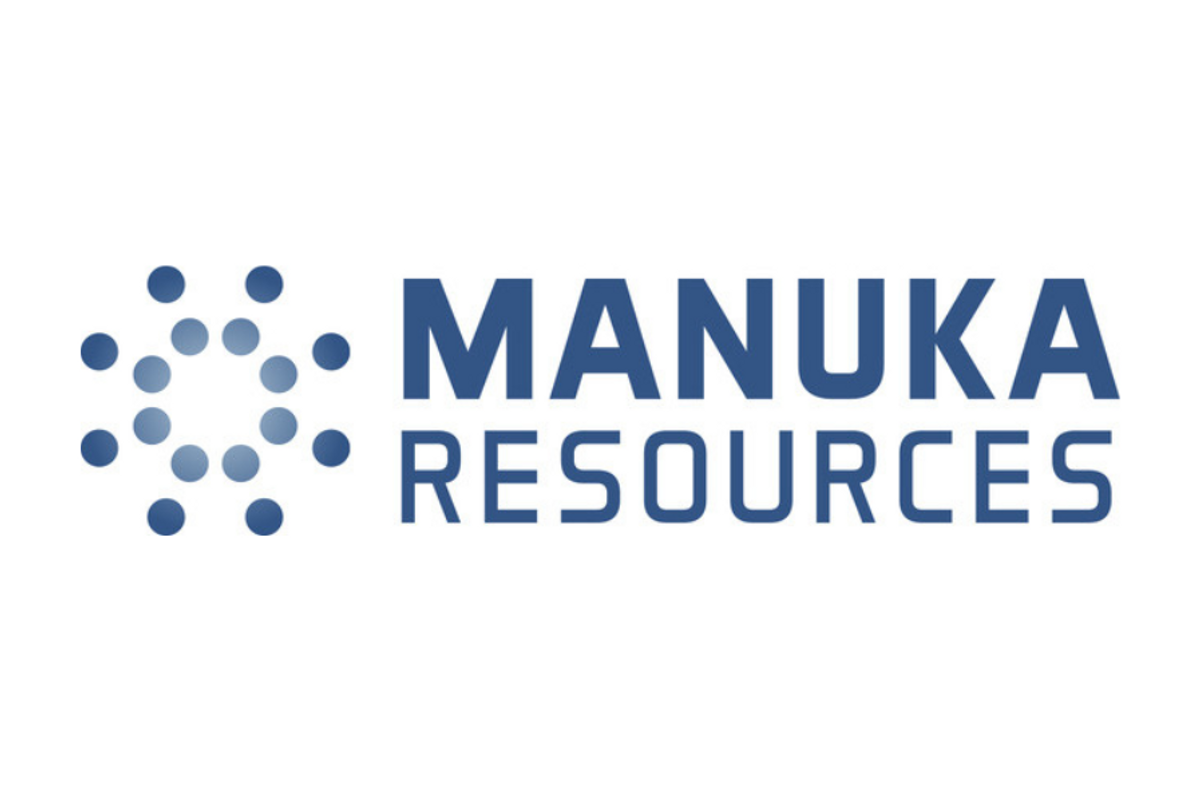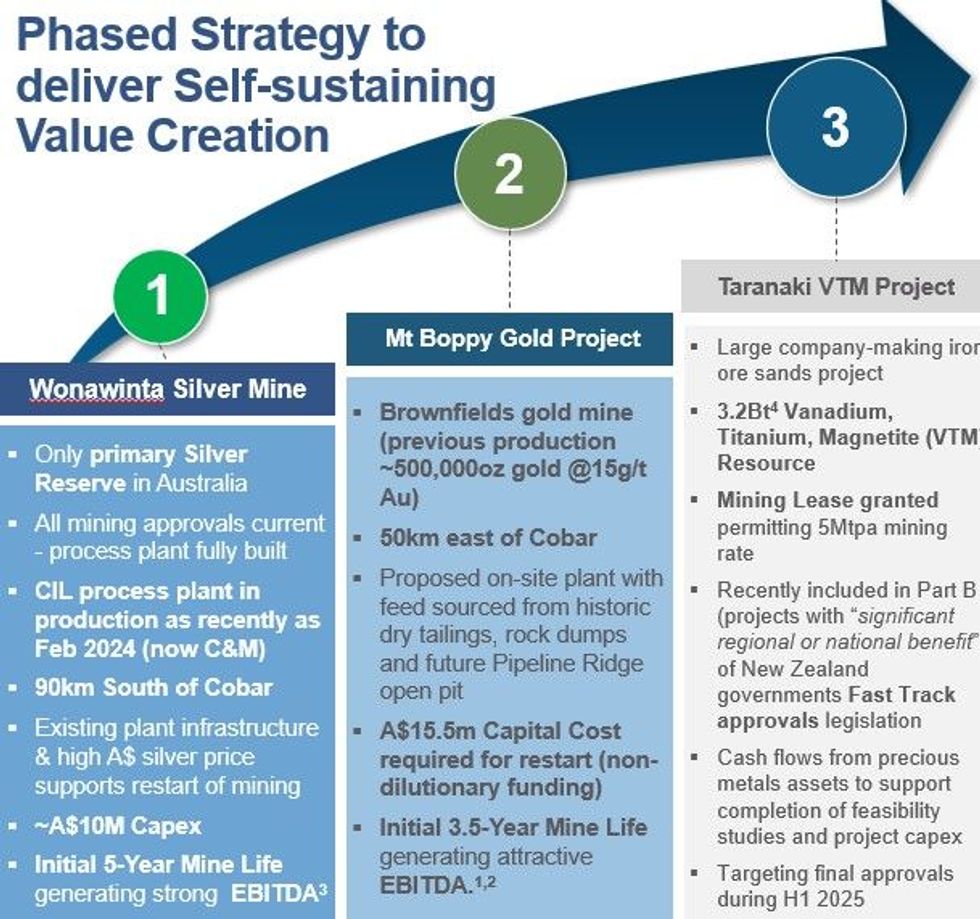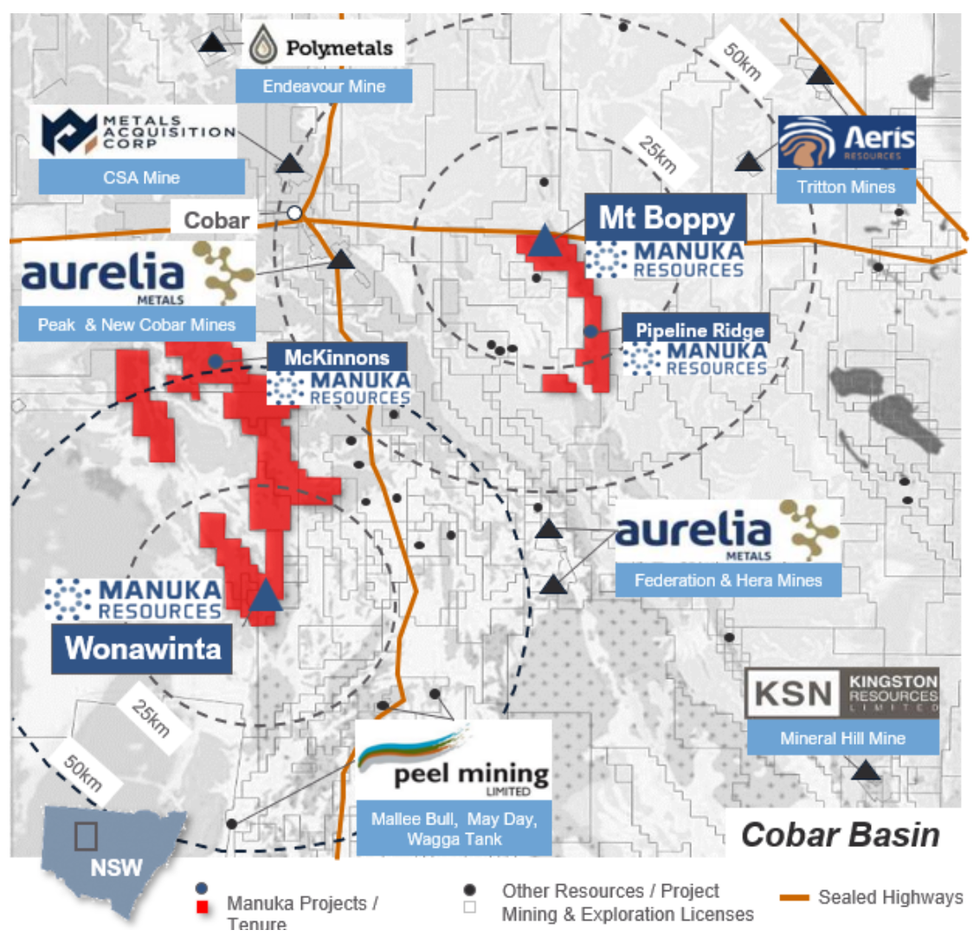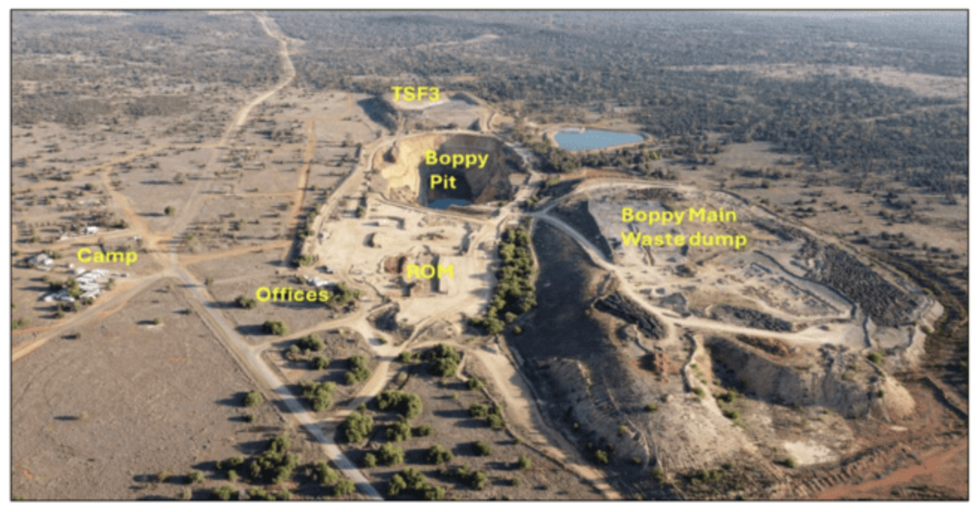
September 19, 2024
Manuka Resources Limited (“Manuka” or the “Company”) is pleased to advise that it has reached an agreement with TransAsia Private Capital Limited (“TransAsia”) to extend the maturity date of its existing debt facility to 31 January 2025.
As previously advised1, Manuka is executing its development plan to restart production from its 100% owned Mt Boppy gold mine (“Mt Boppy”) located in the Cobar Basin, NSW. The development plan includes a fit-for-purpose low capex processing facility at Mt Boppy to produce gold doré.
In parallel with development works at Mt Boppy, Manuka is advancing a process to refinance the TransAsia debt facility, which has yielded proposals from multiple parties. The extension will facilitate completion of the refinancing process and align this with the restart of Mt Boppy.
Manuka’s Executive Chairman, Dennis Karp, commented:
“Once again, we wish to note our appreciation of the ongoing support provided by TransAsia. They have been an outstanding financing partner for Manuka from 2019 and continue to provide us with the flexibility to ensure a positive outcome for the Company and its growth strategy.”
Over the coming months, the Company anticipates:
1. releasing an updated production forecast for the Mt Boppy gold project
2. completion of the refinancing of the TransAsia debt facility
3. recommencement of mining operations at Mt Boppy; and
4. releasing of a restart feasibility study and Ore Reserve for Wonawinta.
Furthermore, the Company is awaiting feedback on its application to the New Zealand Government with respect to the inclusion of the Taranaki vanadium-titanomagnetite iron sands project (“Taranaki VTM Project”) in the Fast Track Consenting approvals list. Subject to final approvals, the Company will use cashflows from Mt Boppy and Wonawinta to advance the world-class Taranaki VTM Project through a Bankable Feasibility Study and toward an investment decision. Vanadium and titanium have both been included in the NZ Government’s recently released draft Critical Minerals List2.
BurnVoir Corporate Finance are acting as Financial Advisors to the Company.
Click here for the full ASX Release
This article includes content from Manuka Resources Limited, licensed for the purpose of publishing on Investing News Australia. This article does not constitute financial product advice. It is your responsibility to perform proper due diligence before acting upon any information provided here. Please refer to our full disclaimer here.
MKR:AU

Sign up to get your FREE
Manuka Resources Investor Kit
and hear about exciting investment opportunities.
- Corporate info
- Insights
- Growth strategies
- Upcoming projects
GET YOUR FREE INVESTOR KIT
The Conversation (0)
26 March
Manuka Resources
Investor Insight
Manuka Resources’ unique value proposition is focused on its three fully licenced projects, which include two precious metals assets in one of Australia’s most prolific regions for base and precious metals, and a company-making iron sands (vanadium and titanium co-products) project in New Zealand’s exclusive economic zone (EEZ) off the Taranaki bight. Manuka Resources is well-placed to deliver significant shareholder value, driven by a phased strategy that includes a clear pathway to near-term precious metals production.
Strategy Overview
Manuka Resources (ASX:MKR) is focused on bringing its precious metals assets in the Cobar Basin into production, as well as progressing its New Zealand domiciled Taranaki VTM iron sands project.

The company previously revealed a phased strategy focused on delivering maximum value to its shareholders. The first phase focused on bringing back the Mt Boppy gold mine into production and it released an optimised production plan for the mine restart. At the time, the company believed silver production would follow gold but noted it was flexible in this regard. In any event and simultaneous to this, will be the ongoing development of the Taranaki vanadium titano-magnetite (VTM) project.

The Cobar Basin located in the central-west of New South Wales, is one of the richest mining provinces in Australia, home to some of Australia’s largest mining companies and explorers.
The Mt Boppy gold mine was historically one of the richest in NSW, Australia and produced ~500,000 oz gold at an average grade of 15 grams per ton (g/t) gold. Accordingly, the company is very excited about its exploration potential.

Drone image looking South showing the main components of the Rock Dump and tailing resources in relation to the Mt. Boppy open pit.
The initial five-year mine plan is largely focused on the screening and processing of gold-bearing waste material above ground on the Mt Boppy mine site. The company had been processing these wastes from June 2023 to December 2023 at its Wonawinta plant and now will look to optimize the process.
The Wonawinta silver project will be the largest primary silver producer in Australia and expected to be back in silver production within 12 months. Manuka has released a maiden ore reserve (under its ownership) of 4.8Mt1 at 53.8g/t silver containing 8.4Moz of silver comprising proven ore reserves of 0.8Mt at 50.8g/t silver; and probable ore reserves of 4.1Mt at 54.3g/t silver. Ore Reserve is based solely on shallow (<40m deep) oxide material.

The Wonawinta 100tph Ball Mill
The gold and silver market appears to be in an upward trend, with prices for both precious metals hitting their all-time highs recently, in Australian dollar terms for silver, which bodes very positively for MKR.
Company Highlights
- Manuka Resources is an ASX-listed mining company focused on producing gold and silver from its two 100 percent owned fully permitted projects (one gold and one silver) in the Cobar Basin in New South Wales, Australia.
- In addition, MKR’s wholly owned subsidiary Trans-Tasman Resources Limited (“TTR”) is the owner of the Taranaki VTM (vanadiferous titanomagnetite) iron sands project, located in the New Zealand EEZ, off the south-west coast of the north island.
- Manuka released the details of the Taranaki VTM project’s pre-feasibility study (PFS) on 26 March 2025, which highlights the extremely robust economics of the project with an NPV10 of US$1.2B and IRR 39 percent
- TTR will also be lodging its application under New Zealand’s Fast Track Approvals Act for the Taranaki VTM project imminently. (The project was included in Schedule 2 of the Act). Successful conclusion of review under the Fast Track pathway will result in final regulatory approvals (marine discharge consent) being granted, completing the full suite of consents to operate the project for 20 years.
- The Company’s primary focus for its precious metals assets is on bringing both the fully permitted Wonawinta silver project and the Mt Boppy gold mine back into production during 2025. The Wonawinta processing plant (primarily constructed for silver production in 2012 with production capacity of 850,000-1 million tpa) has been recently used for both gold and silver processing and is on active care and maintenance for rapid restart..
- The Wonawinta silver project was previously the largest primary producer of silver in Australia, and Manuka expects this to again be the case once production restarts.
- While the substantially higher gold prices have been securing headlines over the past six months, it is worth noting that the silver price is also trading at an all time high which makes restarting the project very attractive (the all time high for silver is against the Australian dollar, currently silver is around AU$54/oz silver).
- Manuka released its maiden silver reserve in October 2024 making it the only production ready silver reserve on a project based in Australia.
- Elevated gold and silver prices should materially benefit Manuka Resources, resulting in strong profitability and cash flows once its projects move into production.
Key Projects
Mt Boppy Gold Project

The Mt Boppy gold project comprises three mining leases, four gold leases and one exploration license, spanning an area of more than 210 sq km in the prolific Cobar Basin in New South Wales, Australia. The project was acquired by Manuka in 2019 and has a current mineral resource of 4.3 Mt at 1.19 g/t gold. This includes a combination of oxidized and transitional/fresh mineralization in the ground, as well as mineralized rock dumps and tailings.
Historically, Manuka Resources has processed its stockpiles and gold mineralized waste products through its Wonawinta processing plant. However, inefficiencies associated with trucking and processing ore at the distant Wonawinta plant has led the company to revise its strategy. It is now looking to construct a processing plant at Mt Boppy so that ore from the mine can be processed on-site. Mt Boppy has excellent infrastructure including a 48-person mine camp and is fully permitted for the proposed processing plant and on-site production.

The updated mineral resource comprises 4.28 Mt at 1.19 g/t gold for 163 koz of contained gold, of which 82 percent is in the measured and indicated categories.
An on-site plant will offer significant cost savings and improve the project economics.
Manuka Resources anticipates Mt Boppy to deliver total EBITDA of >AU$90 million and cash flow of >AU$80 million over a five-year mine life.
Wonawinta Silver Mine Project

The Wonawinta plant
The Wonawinta project is fully permitted with all the necessary infrastructure, including an 850,000 to 1 million tpa processing plant. The plant has been used for processing ore from Mt Boppy. The Wonawinta silver mine is currently under care and maintenance. The company is considering the possibility of resuming operations at Wonawinta, leveraging the improved silver price environment. Manuka has released a maiden ore reserve (under its ownership):
- Ore Reserve of 4.8 Mt at 53.8 g/t silver containing 8.4 Moz of silver comprising:
- Proved Ore Reserves of 0.8 Mt at 50.8 g/t silver; and
- Probable Ore Reserves of 4.1 Mt at 54.3 g/t Ag.
The maiden silver ore reserve and the preparation of an implementation plan for Wonawinta support the potential restart of silver mining and processing operations in the near
future. The company is reviewing its silver restart plans in light of the current price increases and expects to announce a decision before the end of May 2025.
Taranaki VTM Project

The Taranaki VTM project is located within New Zealand's exclusive economic zone, approximately 22 to 36 kilometres offshore, outside the 12 nautical mile boundary from the coastline. The project boasts a JORC resource of 3.2 billion tons at 10.17 percent iron oxide, 1.03 percent titanium dioxide and 0.05 percent vanadium oxide. It holds a mining license allowing initial extraction of 50 million tons annually, resulting in 5 million tons of VTM concentrate per year for 20 years (concentrate grade of 56 to 57 percent iron, 8.5 percent titanium dioxide and 0.5 percent vanadium pentoxide). At this extraction rate, the JORC resource provides approximately 60 years of potential mining inventory.
The project was included in the New Zealand government's Schedule 2 of the Fast Track Approvals Act 2024. The next step for Manuka was to complete pre-feasibility study (“PFS”) on the project. This was released to the market on 26 March 2025 and presents an extremely robust economic outlook for the project as can be seen below.

Management Team
Dennis Karp – Executive Chairman
Dennis Karp is a former commodities trader with nearly four decades of corporate experience. He started his career in 1983 and worked in HSBC until 1997 before moving to Tennant, one of Australia’s largest physical commodities trading companies with operations in Asia and Europe. He was a principal shareholder of Tennant Metals until 2010 and a managing director until December 2014. He founded ResCap in December 2014. Since then, he has participated in diverse resource projects and investment opportunities across base metals and bulk commodities. He holds a Bachelor of Commerce from the University of Cape Town.
Alan Eggers – Executive Director
Alan Eggers has over 40 years of experience in the mining sector. He is a geologist and was the founder of Summit Resources, which became an ASX top 200 company and was acquired by Paladin Energy in 2007 for AU$1.2 billion. Throughout his career, he has held director positions at numerous companies. He holds a Bachelor of Science, Honours, and Master of Science degrees from Victoria University of Wellington. He is recognized as a fellow of the Society of Economic Geologists and holds memberships in AusIMM and the Australian Institute of Geoscientists.
John Seton – Non-executive Director
John Seton is a lawyer with extensive experience in the mineral resources sector. He has served as director in several ASX and NZX listed companies. He holds a Bachelor of Laws from Victoria University, Wellington, and a Master of Law (Honours) from the University of Auckland and is a chartered fellow of the New Zealand Institute of Directors.
Haydn Lynch – Chief Operating Officer
Haydn Lynch has over 25 years of experience in M&A, capital markets and private equity. He has been involved in executing several domestic and cross-border transactions in various sectors including metals and mining, and industrials. He has held leadership roles in global investment banks, including Bankers Trust Australia, Investec Bank, RBC Capital Markets and Southern Cross Equities. He has undergraduate degrees in mechanical engineering and economics from the University of Queensland and a Master in Commerce from the University of New South Wales.
Dieter Engelhardt – Chief Metallurgist and General Manager
Dieter Engelhardt has over 30 years of experience in the mining industry including roles as senior metallurgist at Telfer Gold Mine and Northparkes Mines, resident manager at McKinnons Gold Mine, and manager of ore processing at CSA Mine. Engelhardt was employed by Newcrest Mining (now Newmont) in various roles, including as manager of ore processing and principal metallurgist.
Phil Bentley – Chief Geologist
Phil Bentley has over 40 years of experience in the mining industry across New Zealand, South Africa, and Australia, holding senior geological roles as well as senior management and director positions. He has worked as a chief geologist at Randgold Resources and Randgold & Exploration, Global Head of Exploration at Trafigura Mining Services, and Principal Geologist Africa at CSA Global South Africa. He is a Qualified person under NI 43-101 (Canada) and JORC (Australia) and is a Fellow of the South African Geological Society. He holds a Bachelor of Science (Honours) in Geology at Victoria University of Wellington. He also has a Masters of Science in Economic Geology at Victoria University of Wellington and a Master’s of Science in Mineral Exploration from Rhodes University, Grahamstown South Africa.
Keep reading...Show less
Near-term production from both its silver and gold projects located in the Cobar Basin, Central West, New South Wales
10 July
Further Information to 26 June Announcement
08 July
$8 Million Fully Underwritten Entitlement Offer
1h
Targets Defined for Maiden Drill Program
1h
Quarterly Activities and Cashflow Report
2h
Aircore Doubles Lighthorse Strike Prompts RC Drilling
4h
Adrian Day: Gold Price Drivers Stacking Up, Any Pullback a Chance to Buy
Adrian Day, president of Adrian Day Asset Management, shares his latest thoughts on gold.
He also discusses the opportunity in gold stocks, saying that while as a group they're up 55 percent in last year, valuation metrics are lower than they were two years ago.
Don't forget to follow us @INN_Resource for real-time updates!
Securities Disclosure: I, Charlotte McLeod, hold no direct investment interest in any company mentioned in this article.
Keep reading...Show less
5h
Finding Gold: Exploring New Zealand’s Next Big Discovery
Despite its rich mining legacy, New Zealand remains one of the most underexplored frontiers for gold in the developed world. Now, with advanced exploration tools and a new generation of explorers, the country is emerging as a hotbed of untapped investment opportunity.
Modern exploration activities and promising geologies across the country may offer indications of where New Zealand’s next big gold discovery could be.
Golden legacy
New Zealand's gold-mining history dates back to the 19th century, with historic rushes in Otago and the Coromandel regions. Two standout deposits have cemented the country's credentials — the Martha mine near OceanaGold's (TSX:OGC,OTCQX:OCAND) Waihi operations, and the Macraes mine in Otago, also operated by OceanaGold. Macraes is the country’s largest active gold mine, producing more than 5 million ounces since 1990. Meanwhile, the Martha underground mine continues to yield ore from epithermal gold-silver veins that were first mined in the 1880s.
These cornerstone projects reflect two dominant geological settings in New Zealand: orogenic gold systems in Otago and epithermal deposits in the North Island. Yet despite this foundation, much of the country's gold-rich terrain remains untouched by modern exploration.
Leveraging underexplored regions
New Zealand’s reputation as a politically stable, low-risk jurisdiction makes it a compelling place for mineral exploration. But it is the vast areas of underexplored ground that are drawing fresh interest.
In particular, Southland and Central Otago have emerged as areas of growing excitement. These southern regions are underlain by the same prospective terranes as the Macraes deposit but have seen limited drilling and modern geophysical work. Sparse population, favorable land access and existing infrastructure further bolster their potential.
These multiple factors — geology, infrastructure and technology — make a compelling proposition for these regions as the likely location for the next generation of new gold discoveries.
Today’s explorers in New Zealand are armed with advanced geophysical surveys, structural modeling and machine learning algorithms that help refine drill targeting and reduce risk.
Companies like Rua Gold (CSE:RUA,OTCQB:NZAUF), Santana Minerals (ASX:SMI) and New Age Exploration (ASX:NAE) are leading the charge. Rua is targeting high-grade epithermal systems in the North Island.
Santana has seen encouraging drill results at its Rise and Shine project in Otago. Meanwhile, NAE is focused on Central Otago and is applying new tools to revisit overlooked terrain.
Investment spotlight: New Age Exploration
NAE is strategically building a district-scale gold exploration presence in New Zealand, underpinned by advanced technical execution and an experienced board. Its focus spans two highly prospective regions: the Otago South gold project and the Marlborough project — both located within historically mineral-rich but underdrilled terrains.
The Otago project lies within the Otago Schist Belt — home to the Macraes mine — a region widely regarded as one of New Zealand’s most underexplored playgrounds for orogenic gold. NAE holds a substantial tenement package exceeding 1,000 square kilometers, covering a contiguous stretch that incorporates priority targets such as Lammerlaw, Otago Pioneer Quartz (OPQ) and Manorburn. These areas were selected based on historic workings, strong soil and rock-chip geochemistry, as well as structural/geophysical anomalies indicative of Macraes-style mineralization.
At Lammerlaw, the company completed five reverse circulation holes (totaling 458 meters) in its maiden drilling program. The campaign successfully intersected sulfide-mineralized shear zones and quartz veining typical of high-grade schist-hosted systems. These results align with regional structural trends, and NAE has prudently secured EP 61110 (Waipori) to expand control along the same structural corridor. Results from this first-phase drilling are pending, with a planned Phase 2 drilling campaign slated for early 2026 — targeting newly defined or previously inaccessible zones.
The broader Otago package also includes the OPQ project, which hosts a 6 kilometer gold-bearing shear zone with surface rock-chip grades exceeding 1.4 grams per tonne gold, and the recent addition of the Manorburn permit (approximately 222 square kilometers) adjacent to Santana Minerals’ Bendigo-Ophir discovery, further expanding NAE’s control to approximately 558 square kilometers in the Otago schist belt.
To complement Otago’s high-grade potential, NAE also secured the Marlborough project, encompassing 499 square kilometers within the Marlborough Schist Belt, considered a structural analogue to Otago but previously underexplored. This project diversifies NAE’s exposure and supports a multi-pronged gold discovery strategy.
Driving NAE’s strategy is chairman Alan Broome AM, a highly regarded figure in the Australian mining industry with more than four decades of experience across mining, technology and government advisory roles. A former director of multiple ASX-listed resource companies, Broome brings deep insight into project development and strategic leadership.
Complementing this is a superb local technical team led by Kerry Gordon, a New Zealand-based geologist with extensive experience in Otago-style gold systems, and James Pope, a structural geologist with a deep understanding of the region’s mineralization controls.
Investor takeaway
With New Zealand on the verge of new and significant gold discoveries, investors looking to evaluate early-stage success in the country’s exploration sector should watch for:
- High-resolution geophysical anomalies aligned with shear zones or known fault systems.
- Soil or rock chip assays that detect gold pathfinders like arsenic, antimony or tungsten.
- Drill intercepts with visible sulfide mineralization or quartz vein textures.
- Permit expansion and land consolidation, which point to long-term development strategy.
- Teams with clear communication and technical expertise — an area where NAE stands out.
With favorable geology, strong project economics and world-class leadership teams, New Zealand is quickly becoming a global focus for orogenic and epithermal gold exploration. For investors seeking discovery-stage exposure with substantial upside, early mover explorers may be writing the next great chapter in the country's gold story.
This INNSpired article is sponsored by New Age Exploration (ASX:NAE). This INNSpired article provides information which was sourced by the Investing News Network (INN) and approved by New Age Exploration in order to help investors learn more about the company. New Age Exploration is a client of INN. The company’s campaign fees pay for INN to create and update this INNSpired article.
This INNSpired article was written according to INN editorial standards to educate investors.
INN does not provide investment advice and the information on this profile should not be considered a recommendation to buy or sell any security. INN does not endorse or recommend the business, products, services or securities of any company profiled.
The information contained here is for information purposes only and is not to be construed as an offer or solicitation for the sale or purchase of securities. Readers should conduct their own research for all information publicly available concerning the company. Prior to making any investment decision, it is recommended that readers consult directly with New Age Exploration and seek advice from a qualified investment advisor.
Keep reading...Show less
14 July
High Priority Gold Targets to be drilled at Leonora South
Latest News

Sign up to get your FREE
Manuka Resources Investor Kit
and hear about exciting investment opportunities.
- Corporate info
- Insights
- Growth strategies
- Upcoming projects
GET YOUR FREE INVESTOR KIT
Latest Press Releases
Related News
TOP STOCKS
American Battery4.030.24
Aion Therapeutic0.10-0.01
Cybin Corp2.140.00







